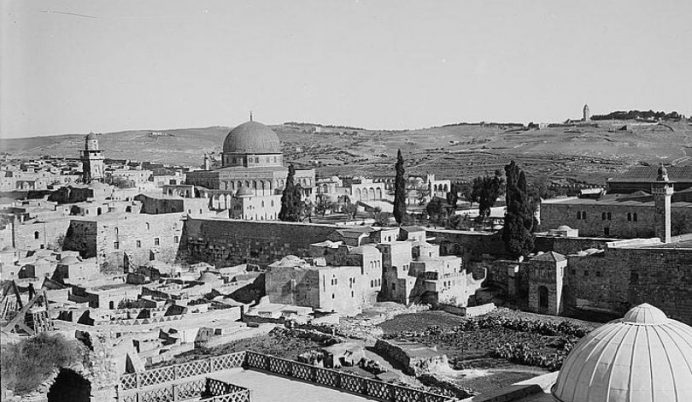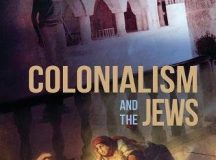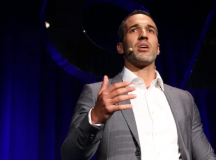Some authors are unwilling to dispense with unsubstantiated stories, opting instead to put scholarly standards aside in their attempts to advance anti-Zionist arguments. Shai Afsai looks at one case in point: the ‘married to another man’ fable.
In the introduction to his influential history of the Arab-Israeli conflict, The Iron Wall: Israel and the Arab World (W. W. Norton & Co., 2000), Oxford University Professor Avi Shlaim discusses Jewish reactions to Theodor Herzl’s 1896 book:
The publication of The Jewish State evoked various reactions in the Jewish community, some strongly favorable, some hostile, and some skeptical. After the Basel Congress [i.e., the First Zionist Congress, in 1897] the rabbis of Vienna sent two representatives to Palestine. This fact-finding mission resulted in a cable from Palestine in which the two rabbis wrote, “The bride is beautiful, but she is married to another man.”
Though that story about the Land of Israel/Palestine being reported as lovely but already taken lacks a primary source, and though there has been no basis for recounting it as a historical event that occurred during the early years of the Zionist movement, versions of it have appeared in a host of books and articles, spreading particularly rapidly after the publication of Shlaim’s The Iron Wall.
University of Exeter Professor Ghada Karmi, for instance, based the title and thesis of her Married to Another Man: Israel’s Dilemma in Palestine (Pluto Press, 2007) — in which she called for the dissolution of the Jewish state — on the story. Former Swedish diplomat Ingmar Karlsson followed Karmi’s lead a few years later with his 2012 anti-Zionist book Bruden är vacker men har redan en man: Sionisme – en ideologi vid vägs ände? (The bride is beautiful but there is already a husband: Zionism – an ideology at the end of the road?)
Often, no source at all is provided for the story by its tellers, as is the case in Shlaim and Karmi’s works. At other times, a specious one is presented. For example, the opening paragraph of Professor Mustapha Marrouchi’s 2011 article ‘Cry No More for Me, Palestine-Mahmoud Darwish’ (College Literature 38:4), cites Henry M. Christman’s The State Papers of Levi Eshkol as a source for the story. There is no ‘married to another man’ story in Christman’s book, however.
In some versions of the story it is the First Zionist Congress — rather than the rabbis of Vienna — that dispatches the explorers to the Land of Israel. In others, it is Herzl himself who sends the rabbis and receives their reply. In a less widespread variant, the ‘married to another man’ story is not set in Western Europe, during the lifetime of Herzl, or even in the 19th century. University of Haifa Professor Benjamin Beit-Hallahmi related the following in his Original Sins: Reflections on the History of Zionism and Israel (Pluto Press, 1992):
There is a famous story, told during a meeting between Prime Minister Golda Meir and a group of Israeli writers in 1970. A Jew from Poland visited Palestine in the 1920s. On his return to Europe, he summarized his impressions by saying: ‘The bride is beautiful, but she has got a bridegroom already.’ Golda Meir responded by saying: ‘And I thank God every night that the bridegroom was so weak, and the bride could be taken away from him.’
As is the case with the two rabbinic representatives from Vienna in other versions, the lone Jewish traveller to Palestine in Beit-Hallahmi’s ‘famous story’ is unnamed. Moreover, his town or city of origin is not identified, nor is a specific year given for when his visit to Palestine or return to Poland were to have occurred. Beit-Hallahmi also does not provide a date for the meeting between Meir and the group of Israeli writers, the name of the writer who brought up the ‘famous story,’ or a source for the Prime Minister’s stated reaction to it.
Regardless of its different details, the ‘married to another man’ story’s central point is often the same. Already in the early years of the Zionist movement, the suggestion goes, Jews recognised that it would be wrong for them to try to obtain the Land of Israel/Palestine, as it was inhabited by Arabs and wedded to them. Despite this, the Zionists proceeded with their plans for Jewish statehood there. From the outset, therefore, Zionism was resolutely immoral, and at its core the establishment of the State of Israel was an act of willful injustice. It is but a small step from there to the conclusion that the Zionist state should be dismantled, ending decades of injustice. Karmi, Karlsson, and Marrouchi eagerly take that step. Shlaim, too, now favours a one-state solution.
The potential anti-Zionist uses inherent in the ‘married to another man’ story are irresistible to many authors, despite the lack of a primary source or a historical basis for its retelling, and accounts for much of its popularity. In this way it resembles a less-frequently told anecdote — involving Herzl and his right-hand man, Max Nordau — that is also meant to demonstrate the Zionist leadership’s supposed early cognisance of the immorality of its Middle Eastern programme. When Nordau first learned that there was a sizable Arab population in the Land of Israel/Palestine — so goes the anecdote — he ran to Herzl, crying, ‘I did not know that. But then we are committing an injustice.’ A kind of amalgamation of both stories is found in Golda’s Balcony (Applause Books, 2003), William Gibson’s one-woman play about Golda Meir, during which her character tells the audience: ‘I dreamed of a paradise, what went wrong?— only what a traveller came back to Vienna to tell the founder of Zionism, “But Herzl, there are Arabs in Palestine!”’
I first published an article about the ‘married to another man’ story (‘“The bride is beautiful, but she is married to another man”: Historical Fabrication and an Anti-Zionist Myth,’ Shofar: An Interdisciplinary Journal of Jewish Studies 30:3) in 2012. (Shofar is published by Purdue University Press on behalf of the university’s Jewish Studies Program.) I recall receiving a congratulatory email from Professor Benny Morris after the publication of my article, in which he cautioned me not to be surprised if the story continues to be peddled. How right he was. Others — including the blogger Elder of Ziyon, Hadar Sela, and Lisa Abramowicz — have subsequently also addressed misuses of the story, and no primary source has since surfaced, but the story is still repeated uncritically.
While Karmi, for example, admitted that she searched hard for the story’s source, was unable to find one, and fears it is apocryphal, she offered no public correction of her scholarship and persists in presenting the story as historical fact on her website. When Avi Shlaim published an ‘Updated and Expanded’ edition of The Iron Wall: Israel and the Arab World in 2014, he once again, and without offering a source, included the ‘married to another man’ story. In his new preface, he explained:
My historical method is completely conventional, and it is as old as the hills. I subject the Israel and Arab narratives of the conflict to critical scrutiny in the light of the available evidence and then discard all those notions, however deeply cherished, that do not stand up to such scrutiny.
But Shlaim was not capable of discarding the cherished ‘married to another man’ story — which he now referred to as ‘an apocryphal story’ in the introduction, though without giving any explanation for his reevaluation:
The publication of The Jewish State evoked various reactions in the Jewish community, some strongly favorable, some hostile, and some sceptical. After the Basel Congress, according to an apocryphal story, the rabbis of Vienna decided to explore Herzl’s ideas and sent two representatives to Palestine. This fact-finding mission resulted in a cable from Palestine in which the two rabbis wrote, ‘The bride is beautiful, but she is married to another man.’
The story also showed up around the same time in Associate Professor Eve Spangler’s Understanding Israel/Palestine: Race Nation, and Human Rights in the Conflict (Sense Publishers, 2015). Like Shlaim, she explains her methodological considerations in her introduction: ‘Readers of non-fiction must rely on the author to marshal facts and to tell a story that is an honest representation of the situation.’ Nevertheless, in order to bolster her factual and true statement that ‘Zionist leaders certainly knew that the land [i.e., Palestine] was not empty,’ she marshals the ‘married to another man’ story: ‘In the rather poetic metaphor attributed to Zionist planners, the bride was very beautiful but already claimed by another.’ Spangler’s endnote reference for the Zionist planners’ ‘poetic metaphor’ points to Shlaim’s 2000 edition of The Iron Wall and Karmi’s Married to Another Man, neither of which, as mentioned, furnish a source for the ‘married to another man’ story. Further along in that endnote, Spangler writes:
Recently, Shai Afsai, a Zionist polemicist, has challenged the authenticity of the phrase without, however, being able to dispute that early Zionist leaders, whether they were given to poetic language or not, knew that Palestine was inhabited by Palestinians.
I will leave it to the reader to conclude whether or not I am ‘a Zionist polemicist,’ a descriptor that Spangler thinks somehow relevant to the question of the ‘married to another man’ story’s authenticity. Reading Spangler’s endnote, I was reminded of Mondoweiss editor-at-large Annie Robbins’s unreservedly bigoted attempts to evade the question of the ‘married to another man’ story’s authenticity (which had been raised in the comments to Iris Keltz’s 27 March 2013 Mondoweiss article ‘Lessons learned from a box of matzoh’): ‘oh, so a jewish scholar claims it’s a fabrication’ and ‘one paper from Purdue University’s Jewish Studies Program does not make for a proper debunking.’ (I imagine that for Robbins, Zionist polemicists are as inherently disreputable as Jewish scholars and Jewish Studies programmes.) But eventually — unable to find a source to bolster the story that she had not wanted to part with — Robbins settled on a different approach: ‘i guess i don’t understand why it really matters.’
I am confident I have never tried to dispute that Jews were aware, during Zionism’s early years, that there was an Arab population in the Land of Israel/Palestine, knew that the Arab population was significant relative to the Jewish population, and realised that much of the Arab population did not want Jews to immigrate there or to establish a Jewish state. On the contrary, I have emphasised all of that in my writings, sometimes to the dissatisfaction of newspaper editors who sought less nuanced descriptions of the Arab-Israeli conflict. I contended in my 2012 Shofar article that there is no need to resort to contrived stories in order to prove those points. Yet many authors on the Middle East are unwilling to dispense with unsubstantiated stories, opting instead to put scholarly standards aside in their attempts to advance anti-Zionist arguments. Spangler’s endnote is indicative of her book as a whole, which looks to have been written more with an intent to mislead and obfuscate about Israel/Palestine than to give a genuinely interested reader a candid representation.
A very recent example of disregard for scholarly standards is found in Professor Mohsen Mohammad Saleh’s May 2020 al-Zaytouna Centre article, ‘Did the Palestinians Sell Their Land? And Leave it to the Jews?!’ Saleh writes:
According to a frequently repeated anecdote, after the Basel Congress, held in 1897, the rabbis of Vienna decided to explore Theodor Herzl’s ideas, and sent two representatives to Palestine. This fact-finding mission resulted in a cable from Palestine in which the two rabbis wrote, “The bride is beautiful, but she is married to another man”!! That is, there are people already living there. The story resembles another commonly repeated anecdote, involving Theodor Herzl and his right-hand man Max Nordau. When Nordau first learned that there was a sizable Arab population in Palestine, he ran to Herzl, crying, “I did not know that. But then we are committing an injustice.”’
The sources that Saleh cites for that paragraph’s information are Beit-Hallahmi’s Original Sins; Shlaim’s 2001 edition of The Iron Wall; and a short 2 May 2015 Jewish Link article I published titled ‘The “Married to Another Man” Story and Zionism.’ It seems, however, that Saleh simply read my short article, and then added Beit-Hallahmi and Shlaim’s books to his endnotes for better effect. I noted in the Jewish Link that ‘Professor Benjamin Beit-Hallahmi of the University of Haifa recounted a version of the [‘married to another man’] story in his Original Sins,’ and I also discussed Shlaim’s use of the story. But none of the information Saleh presents is found in Beit-Hallahmi’s book, which as mentioned, contains a less common (though also unsourced) version of the ‘married to another man’ story. And neither Beit-Hallahmi nor Shlaim include the Herzl/Nordau story in their books. In other words, Saleh’s source for the ‘married to another man’ and Herzl/Nordau stories — which he repeats in order to support the idea that Zionist settlers found Arab-inhabited Palestine a place ‘full of vitality and activity, where hardworking people live, deeply rooted in their land’ — is actually an article in which I stated plainly that ‘the “married to another man” and Herzl/Nordau stories are themselves unsupported’.
Although the ‘married to another man’ and Herzl/Nordau stories are themselves unsupported, questions about the justice of Zionist goals did in fact preoccupy various Jewish, as well as Arab, thinkers in the late 19th and early 20th centuries, as they do today. In contrast to much of current official anti-Zionist propaganda, however, Arab leaders opposed to Zionism a century ago or so were quite willing to acknowledge that the Jewish nation had formerly dwelled and thrived in Palestine. That bygone honesty may be contrasted with, for example, former Palestinian Authority Mufti Ikrima Sabri’s 11 May 2012 assertion on Al-Arabiya TV that there are no places holy to the Jews in Jerusalem and that no archeological remains pertaining to Jewish holy places have ever been found there.
Unlike Sabri, early Arab opponents of Zionism did not deny Jewish history in the Land of Israel/Palestine, but rather maintained that as Arabs now inhabited it, such history was immaterial. In an 1899 letter to Rabbi Zadok Khan — the Chief Rabbi of France — for instance, Khalidi Yusuf Dia al-Khalidi wrote: ‘Who can challenge the rights of the Jews on Palestine? Good Lord, historically it is really your country.’ Nonetheless, al-Khalidi urged the Jews to look elsewhere for a homeland. ‘Good Lord, the world is vast enough, there are still uninhabited countries where one could settle millions of poor Jews who may perhaps become happy there and one day constitute a nation … But in the name of God, let Palestine be left in peace,’ al-Khalidi wrote. Even the notoriously antisemitic and Nazi-allied Mufti Haj Amin al-Husseini tacitly acknowledged Jewish history in the Land of Israel, urging the British government in November 1936 to look on Palestine as a purely Arab country by arguing that the Jews left the land 2,000 years ago. Instead of returning to Palestine, they should now go to other parts of the world, he said, where there are vacant places.
Zionist leaders, however, believed that Jewish history in the Land of Israel/Palestine was indeed relevant, and that Jews had a right to return to their ancestral land and to the cradle of their religion, even if Arabs were currently in the majority there. In his 1923 essay ‘The Ethics of the Iron Wall,’ for example, Ze’ev Jabotinsky wrote:
There are no more uninhabited islands in the world … the whole earth has been allocated … [It is said that] if homeless Jewry demands Palestine for itself it is ‘immoral’ because it does not suit the native population. Such morality may be accepted among cannibals, but not in a civilised world.
Jabotinsky stressed that Arabs possessed immense stretches of land, while the Jews, who were in desperate need of a country, possessed none. ‘It is an act of simple justice to alienate part of their land from those nations who are numbered among the great landowners of the world [i.e., the Arabs], in order to provide a place of refuge for a homeless, wandering people [i.e., the Jewish people],’ he argued.
The debates about the justice of reestablishing and preserving a Jewish state in the Middle East are sure to go on for at least as long as the Arab-Israeli conflict does. There is nothing to be gained in such discussions, though, from leaning — as have Shlaim, Karmi, Karlsson, Spangler, and Saleh — on baseless narratives like the ‘married to another man’ story. Disputes involving the Land of Israel/Palestine are complex enough without introducing such fables into the mix.




































